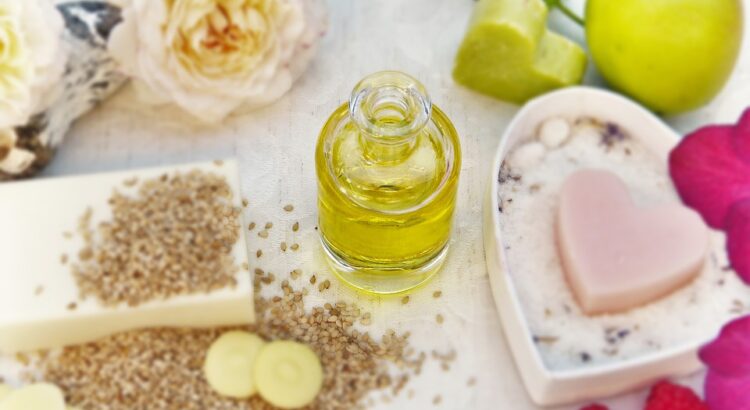Sesame is rich in oil, minerals and vitamins. Yet, its sharp quality makes it damaging if used in excess. When processed with the right herbs, sesame oil can cure most diseases…
The use of sesame (Sesamum indicum) is so prevalent in India as gingelly and in ayurveda as til that almost no Indian is without their favorite ritual, recipe, or prescription.
 The magical volcanic islands on the southeastern border of Akhanda Bharat (ancient India), Sunda islands are the ancestral home of the bell-shaped sesame flower plant that yields long pillow-like pod fruits sometimes containing nearly 100 sesame seeds. The bells come in various colours and indicate something of their ayurvedic energetic properties. Sesame seeds, which also come in different colours and indicate difference nuances of subtle panchabhuta energy, contain about 50% fixed oil and packed with minerals and vitamins. Because of their high oil content, they have been traded and exploited for thousands of years, altered naturally into different variants by soil and climate variations. Records of the use of sesame are 5000+ years old in different parts of the world and now are used in cuisines throughout the world.
The magical volcanic islands on the southeastern border of Akhanda Bharat (ancient India), Sunda islands are the ancestral home of the bell-shaped sesame flower plant that yields long pillow-like pod fruits sometimes containing nearly 100 sesame seeds. The bells come in various colours and indicate something of their ayurvedic energetic properties. Sesame seeds, which also come in different colours and indicate difference nuances of subtle panchabhuta energy, contain about 50% fixed oil and packed with minerals and vitamins. Because of their high oil content, they have been traded and exploited for thousands of years, altered naturally into different variants by soil and climate variations. Records of the use of sesame are 5000+ years old in different parts of the world and now are used in cuisines throughout the world.
Ayurvedic wisemen considered sesame oil as the King of Oils because of 3 main properties.
-
- sroto-sodhana (channel-cleansing)
The wisemen describe a unique property of sesame oil as sroto-sodhana (channel-cleansing). Think of swallowing something that scrapes away phlegm and excess lying on the edge of microchannels it passes through. Great! As the body is full of fat-lined cells and vessels, those with residue stuck to the edges would benefit from a small amount of scraping. However, too much and for too long, that same sesame oil that was cleansing will begin to chafe and wear down the walls, creating damage. The tissues begin to break down.

The ancient Ayurvedic medical text Astanga Hrdayam describes sesame as the chief vegetable oil to understand before use, due to its severe properties of teeksna (sharp in action), vyavaayi (ability to spread quickly in the tissues of the body), and tvak doshi (causes skin eruptions when eaten in excess) (Ayurvedic source: AH Sū.5.55). This seems mysterious unless you have a strong grasp of ayurvedic physiology.
- vyavaayi (spreading quickly)
Ingested into the body, sesame oil spreads quickly throughout (vyavaayi) and acts with its sharpness to penetrate and open up clogged spaces before it is able to be metabolised by the tissues; this is also a common property of poisons. So, it is important not to ingest too much.
However, this ability of sesame oil to penetrate is exactly why it can get into microchannels and small spaces and clean out phlegm, deep scar tissue, and toxins that are waiting to be released because they do not belong there. Microscopic images of sesame seeds using SEM (scanning electron microscope) reveals a series of regular polygonal, honeycomb – like depressions that look like scales measuring 6-10 micrometers across.
Ingested vs. Topical Sesame Oil
The use of sesame on the external body where it is near air conveys very different properties than its use ingested as food, in which it is inside the body, which is 70% water.
If a person thinks a-little-is-good-but-more-is-better, they run the risk of destroying their tissues because the excess sesame oil continues to penetrate deep into the body and opens up the walls of the cells and damages its functions by breaking intercellular bonds and hampering crucial muscle and bone interfaces.
The ayurvedic wisemen tell us that ingested oil in excess is NOT good for the eyes. The eyes are balls of fat, and they should never be exposed to excess heat. Sesame oil is penetrating and heating and can melt down the fat balance in the walls of the body's cells when consumed in excess. While it is an oil, it does not increase kapha, the theme of lubrication, stability and material grounding in the body, because it is teekshna (sharp). In excess, sesame oil also induces constipation. Yet, when processed with the right herbs, sesame oil can cure most diseases (Ayurvedic source: AH Sū.5.56).
- The best medicine for Vata
 Used on the skin of the body ("externally"), sesame oil is a completely different medicine than its use internally.
Used on the skin of the body ("externally"), sesame oil is a completely different medicine than its use internally.
Because it is heating, it calms vata and is a wonderful remedy for calming the gut, the mind, and helping rid insomnia, jetlag, and flighty emotions, which are all due to unharmonious micromovements in the body (vata utklesha). Rubbing the oil under the feet before bedtime results in deeper sleep. Rubbing the oil under the feet and behind the ears before a long airplane or train journey brings less jetlag and less post-travel fatigue. Nightly use during the high-vata times of year, such as the windy monsoons or the oncoming of autumn season, calms the vata rising in the body.
The unique sharpness of sesame oil instills a cleansing property on external surfaces, where the oil can penetrate the dermis and clean toxins submerged in fat and muscle tissue.
Sesame and Cold Weather
During the months of November to January in the northern hemisphere, many Indian festivals celebrate by ritualizing the making and gifting of sesame seed-based sweets. During this cold time of year, a small amount of ingested sesame penetrates to break through the phlegm, heats the body, and prevents skin infections that can occur in the cold season when skin gets dry and cracked.
Caution Goes a Long Way
There are a few cautions for use of sesame oil, as with any ingredient. Sesame oil should not be used if your body is already full of toxins, such as autoimmune antibodies. People arriving to a center for pancakarma are often given a relaxing oil massage, but they feel more tired afterward, and not rejuvenated. This is due to the vyavaayi property of sesame oil, that takes the toxins and carries them across the internal fat highways of the interstitium, spreading the toxins and making them even more difficult to gather up and expel.
Sesame Oil in Ayurverda
The beloved golden yellow sesame oil is clearly highlighted in detail multiple times in the classic texts of ayurvedic medicine, both as a therapeutic food in certain seasons and health conditions, and as the most prescribed component in the intricate medicine-making processes for specific diseases. A majority of ayurvedic oils also use sesame oil as a base or as a component.




 There are several varieties of sesame, with white, cream, yellow, red, tan, brown or black seeds. Europeans preferred the white and cream-coloured seeds, with their white bell-shaped flowers tinted with blue, red or yellow, whereas the Chinese prized the black sesame seeds. Depending on the climate, the plants take 80-180 days to ripen 15-20 fruits with seeds fully and grow 1 to 2 meters tall, with hairy leaves and a characteristic unpleasant odour. Each fruit contains 70-100 seeds. Four billion pounds of seeds are harvested worldwide annually, of which India is the largest producer, mostly by small farmers during arid and hot summers.
There are several varieties of sesame, with white, cream, yellow, red, tan, brown or black seeds. Europeans preferred the white and cream-coloured seeds, with their white bell-shaped flowers tinted with blue, red or yellow, whereas the Chinese prized the black sesame seeds. Depending on the climate, the plants take 80-180 days to ripen 15-20 fruits with seeds fully and grow 1 to 2 meters tall, with hairy leaves and a characteristic unpleasant odour. Each fruit contains 70-100 seeds. Four billion pounds of seeds are harvested worldwide annually, of which India is the largest producer, mostly by small farmers during arid and hot summers. Hanging the collected stems with their fruits upside down, the oblong pods dry until brittle, from which the husked seeds fall free. Once dehusked, the seeds can be used either whole or ground. Crushing the seeds and pressing them can yield 50-60% stable, fixed oil. Because the oil is stable at high heat, it is commonly used for stir frying and high heat cooking. Sesame oil is used raw in salads or as a cooking oil placed into shortening, margarine, and in the manufacture of items requiring a stable oil, such as soaps, lubricants, cosmetics and perfumes due to its hydrating and antioxidant benefits and in pharmaceuticals.
Hanging the collected stems with their fruits upside down, the oblong pods dry until brittle, from which the husked seeds fall free. Once dehusked, the seeds can be used either whole or ground. Crushing the seeds and pressing them can yield 50-60% stable, fixed oil. Because the oil is stable at high heat, it is commonly used for stir frying and high heat cooking. Sesame oil is used raw in salads or as a cooking oil placed into shortening, margarine, and in the manufacture of items requiring a stable oil, such as soaps, lubricants, cosmetics and perfumes due to its hydrating and antioxidant benefits and in pharmaceuticals.


 Salads/ Stir Fries:
Salads/ Stir Fries: Alternately roasted sesame can be added to your Muesli, flakes or the regular seed mix that you keep on your table to address the hunger pangs. It is the most simple and healthy way to add Sesame to your diet.
Alternately roasted sesame can be added to your Muesli, flakes or the regular seed mix that you keep on your table to address the hunger pangs. It is the most simple and healthy way to add Sesame to your diet.












